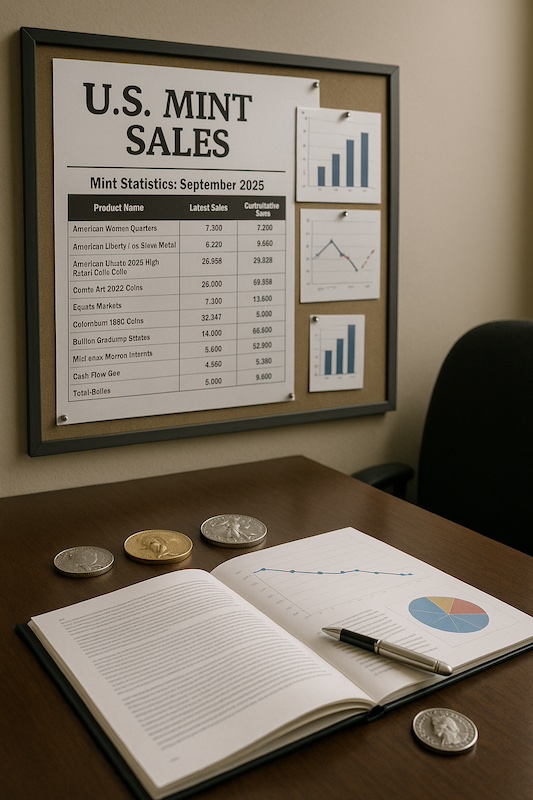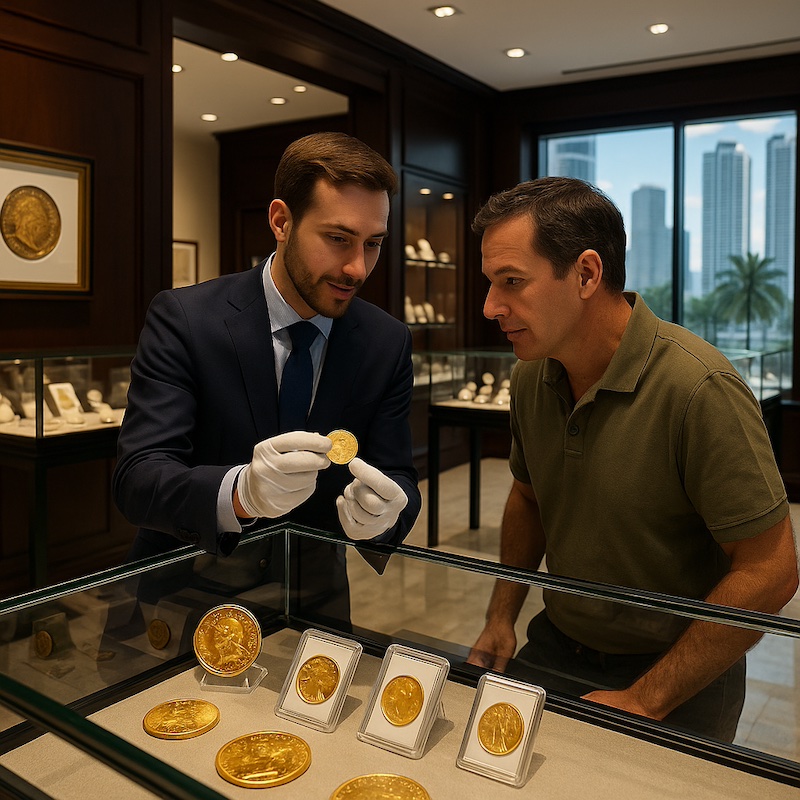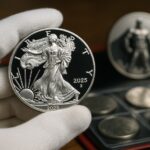Hook: In less than a year, the first new U.S. banknotes in a decade will enter circulation—ushering in fresh anti-counterfeiting tech, raised tactile features for accessibility, and a multi-year rollout that affects everything from ATM uptime to show-floor cash deals. If you handle currency—whether as a collector, dealer, grader, registrar, or investor—the U.S. banknote redesign 2026 is your cue to prepare.
TL;DR
- The Bureau of Engraving and Printing (BEP) will debut a new $10 note in 2026, followed by $50 (2028), $20 (2030), $5 (2032), and $100 (2034). Older designs remain legal tender.
- Expect upgraded security and a raised tactile feature to aid the visually impaired; detailed design reveals come closer to launch.
- Banks and retailers must ensure ATMs, TCRs, sorters, and validators recognize the new notes. As one trade source warns: many “legacy systems [are] not equipped to process or authenticate the new generation of currency.”
- Counterfeits are rarer than two decades ago (≈1 in 40,000–80,000 notes), but technology-driven fraud persists—so authentication training still matters.
Why the U.S. Banknote Redesign 2026 Matters
A major U.S. note redesign is comparatively rare; the last sweeping change (new $100) reached the public in 2013. The BEP now confirms a staggered rollout: $10 (2026), $50 (2028), $20 (2030), $5 (2032), and $100 (2034). That timetable—paired with a commitment to accessibility via a raised tactile feature—signals both security modernization and inclusive design.
For numismatists, staged releases influence collecting strategies (first-year issues, print runs, error note watchlists), while for industry operators the dates drive hardware upgrades, staff training, and customer education. Accessibility groups, including the American Council of the Blind, have tracked the government’s accessibility commitments; public materials note plans for tactile features and accessible authentication tools.
Cash Still Matters—Here’s the Market Context
Despite headlines about “cashless” commerce, the Federal Reserve’s most recent Survey & Diary of Consumer Payment Choice shows cash remains the third-most-used instrument and accounted for ~14% of payments in 2024 by number—critical for small-value transactions and for un/underbanked consumers.
Moreover, the U.S. cash ecosystem is huge: industry estimates placed the ATM population in the 520,000–540,000 range as recently as 2023—equipment that must be updated and tested for new notes.
What’s Changing in the U.S. Banknote Redesign 2026
Security & Accessibility
- Advanced security (details to be disclosed closer to issuance) continues the U.S. tradition of incremental, layered defenses (color-shifting inks, microprinting, threads, 3D features). Expect new machine-readable elements to work with modern sorters and validators.
- Raised tactile feature (RTF) will assist people who are blind or low-vision in identifying denominations by touch—an accessibility upgrade long advocated by stakeholders.
Legal Tender Status
- No note swap required. All older designs remain legal tender indefinitely; you don’t need to trade in notes when a new design appears. That’s longstanding U.S. policy, and it protects collectors and commerce from disruption.
The Release Order
- Official BEP schedule: $10 (2026) → $50 (2028) → $20 (2030) → $5 (2032) → $100 (2034). The agency has not released final public designs. Design participation/portraits will be clarified in official communications closer to each launch.
(About the much-discussed Harriet Tubman concept: advocacy organizations have referenced a future $20 incorporating accessibility; however, the BEP’s public schedule is the definitive source and final designs aren’t yet published.)
Risk & Readiness: Infrastructure Will Make or Break the Transition
“Financial institutions are still operating on legacy systems not equipped to process or authenticate the new generation of currency.” — Bank Automation News, June 2025
That blunt assessment reflects what many branch and cash-center leaders know: ATMs, teller cash recyclers (TCRs), counters, sorters, and validators must be updated—often with sensor firmware, templates, and acceptance logic—before the new notes appear in customer wallets.
- ATMs & ITMs: Require software/firmware loads from manufacturers and acquirers; test suites must reflect new-denomination templates and substrates. With hundreds of thousands in service, scheduling updates and field-validation matters.
- TCRs, counters, and sorters: Vendors such as Giesecke+Devrient already market upgradeable sensor platforms (BPS lines) designed for new series; ensure service contracts cover currency template updates and acceptance testing.
- Retail POS validators: Convenience and big-box lanes rely on bill validators; coordinated updates reduce rejection rates and cashier workarounds. (Operators should coordinate with OEMs and service providers well ahead of 2026.)
The Counterfeiting Picture: Better—but Never Static
The Federal Reserve’s research estimates no more than ~$30 million in counterfeits in circulation—about 1 in 40,000 notes, with a more likely figure of ~1 in 80,000—a dramatic improvement versus 2006 (≈1 in 10,000). But tech-enabled fakes and “prop” notes still surface, and enforcement continues.
- The U.S. Secret Service leads counterfeit investigations and emphasizes evolving threats; it coordinates with banks and cash processors for submissions and adjudication.
- Training still pays. The Federal Reserve reminds the public and tellers that suspected counterfeits should be reported; you won’t be reimbursed for a fake. Authentication knowledge thus remains a first line of defense.
Collecting & Investing Angles: Opportunities and Caveats
Early-Issue Appeal
First-year notes attract attention. For the U.S. banknote redesign 2026, expect collectors to chase high-grade, low-serial, star notes, test pack ephemera, and BEP souvenir cards or educational materials that often accompany rollouts. (Monitor official BEP/USCurrency.gov announcements for public-facing materials.)
Error Watch
New designs + fresh plates + high-volume ramp-ups can create transitional varieties or printing anomalies that become coveted error-note subtypes. While modern quality control is robust, the earliest production months are where “lightning” most often strikes.
Long-Game Rarity Factors
- Print runs & series letters (by facility and year)
- Condition scarcity (uncirculated vs. circulated)
- Special serials (radar, ladders, repeaters)
- Replacement/star notes
None of these guarantees gains—but they guide disciplined collecting.
Balanced Risks
- Authentication drift: As designs change, casual buyers may misidentify enhanced security cues; stick to reputable dealers and third-party grading where appropriate.
- Illiquidity in niche series: Scarcer modern varieties can be thinly traded—research before chasing premiums.
How to Prepare for the U.S. Banknote Redesign 2026 (for Each Audience)
For Coin & Currency Dealers
- Update equipment: Ensure your counters/validators accept the new $10 at launch; schedule vendor updates now.
- Train staff: Use U.S. Currency Education Program materials and teller toolkits to refresh authentication best practices, including tactile and machine-readable features.
- Messaging: Remind customers that older notes remain legal tender—no need to swap—reducing anxiety and misinformation.
For Banks & Credit Unions
- Deployment plan: Coordinate with ATM manufacturers/acquirers and TCR providers for firmware and template updates; pilot-test acceptance to reduce false rejects.
- Customer education: Publish a landing page explaining what’s changing and note-acceptance policy at your machines and branches.
- Accessibility: Incorporate raised tactile feature guidance in teller and call-center scripts.
For Retailers
- Validator updates: Get with POS service firms now to schedule 2026 template loads and cashier training.
- Loss prevention: Review counterfeit response policy; ensure staff know that suspected fakes should be held and reported per Fed/USSS guidance. Reserva Federal
For Collectors & Investors
- Build a checklist: Track series, blocks, and star-note ranges as they’re published.
- Budget for premiums: First-issue novelty can inflate prices; be disciplined, verify print data, and avoid FOMO.
- Stay current: Follow BEP and USCurrency.gov for official updates and public education tools.
Comparison Snapshot: Stakeholder Pros & Risks
| Stakeholder | Pros from Redesign | Risks/Costs | What to Do Now |
|---|---|---|---|
| Collectors/Numismatists | New series to pursue; first-year and error-note opportunities | Early hype premiums; counterfeit confusion | Set targets, study security features, buy from reputable sources |
| Dealers/Auctioneers | Foot traffic & consignments tied to new notes | Equipment update costs; staff training time | Update validators/counters; educate buyers |
| Banks/Credit Unions | Better counterfeit defense; customer trust | ATM/TCR updates; test cycles | Coordinate with OEMs; stage pilot deployments |
| Retailers | Fewer counterfeit losses | POS validator updates; cashier training | Schedule firmware loads; update SOPs |
| General Public | Easier authentication; accessibility | Initial unfamiliarity | Learn tactile & visual checks at USCurrency.gov |
U.S. Banknote Redesign 2026: Frequently Asked Questions
1) Will I need to exchange my old bills when the new $10 arrives?
No. All U.S. designs—old and new—remain legal tender. There’s no mandatory swap.
2) What’s the official rollout schedule?
BEP indicates: $10 (2026), $50 (2028), $20 (2030), $5 (2032), and $100 (2034). Final public designs are disclosed closer to issuance.
3) Is the Harriet Tubman $20 happening?
Advocates have discussed an inclusive $20; accessibility groups highlight tactile features. The definitive source is BEP; until designs are released, treat non-official imagery cautiously.
4) Are counterfeits getting worse or better?
Better than a decade ago: Fed research estimates only 1 in ~40,000–80,000 notes are counterfeit in the U.S., but vigilance is still essential.
5) How will this affect my ATM or store validator?
Machines need firmware/template updates to recognize the new notes; plan updates with your service providers well before launch.
U.S. Banknote Redesign 2026 and the Path Ahead
The U.S. banknote redesign 2026 sits at the intersection of art, security, and accessibility. The timetable is public, the accessibility commitment is clear, and the modernization imperative is urgent for anyone who processes cash at scale. For collectors, the changeover invites a disciplined hunt for first-year pieces and varieties—grounded in data, not hype. For banks, retailers, and CIT operators, success is simple (if not easy): update hardware, train people, and communicate early.
Action steps:
- Bookmark the BEP Currency Redesign and U.S. Currency Education Program pages to track official updates and training materials.
- Schedule machine updates (ATMs/TCRs/sorters/validators) with your vendors and pilot test acceptance well in advance.
- If you’re a collector or dealer, draft a first-issue checklist and set a budget ceiling to keep speculation in check.
- Refresh counterfeit-response SOPs and customer education.
Change is coming—and for the first time in years, it’s tangible, tactile, and designed for everyone who uses U.S. currency. Prepare now, and you’ll turn a potential disruption into an advantage—on the bourse floor, at the branch, and at the register.








